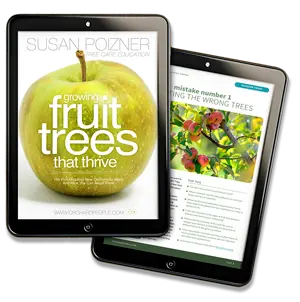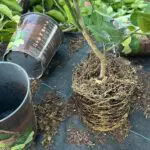How do you choose fruit trees that will work for your landscape? This article and video show you the tips Read more
Bringing Life to Your Soil: How to Improve Soil Quality Naturally

Most people know that to have healthy plants and trees, you need to have healthy soil. However, many people don't realize that their soil is not actually healthy. In most cases, soil is more like dirt - it doesn't have the necessary nutrients and organisms to support healthy plant growth.
In this article you will learn how to improve your soil naturally by encouraging soil life. The tiny creatures in the soil include beneficial bacteria and other microorganisms (also called microbes) and they are helpful to plants and trees in a number of ways.
- Beneficial soil bacteria and other microbes help plants access phosphorus in the soil. Phosphorus is a nutrient that is important for root growth.
- Beneficial soil bacteria and other microbes can convert nitrogen gasses in the tiny pores of the soil into water-soluble nitrogen that our plants can absorb. Nitrogen powers leaf and branch growth.
- Beneficial bacteria and other soil microbes also break down organic matter, releasing minerals that your trees and plants need for good health.
If soil bacteria are present and they are doing their job properly, plants and trees will thrive. And as an extra bonus, with soil organisms releasing nutrients hidden in the soil, you won't need to waste your money on commercial fertilizers.
In this article you will learn how to find out if your soil has a healthy microbe population – and you'll also learn how to nurture and feed those tiny critters so that they, in turn, will feed and nurture your plants.
Let's get started!
how does bacteria improve soil quality naturally?
There is still a lot of mystery around how bacteria in soil functions. But what we do know is that beneficial soil microorganisms love to consume sweet stuff that they find in the soil. Their favourite food sources are high energy carbon sources like sugars.
And those sugars are in the soil because plants put them there! During the growing season, plants and trees harness sunlight to produce energy in a process called photosynthesis. Plants then use this wonderful energy to power their biological functions. It is used to create shoots, buds, blossoms and fruit.
That energy circulates all around the plant from the tips of the leaves to the root system deep underground. But strangely enough, a percentage of that valuable energy that goes to the root system is dumped out into the soil. Why would plants do all the work of producing this sugary, nutritious energy and then throw a portion of that energy away?
Well, there is method to this madness. By releasing sugars (called exudates) into the soil, plants will attract beneficial bacteria to their root systems. That bacteria will flock to the roots to gobble up the sugary exudates. If more and more exudates are being released, the bacteria will stick around and multiply.
Now those hungry bacteria aren't just chowing down on exudates. They are also eating organic matter in the soil including dead plants and animals. When they poop, these tiny microbes release excess nutrients into the soil in a form that plants can take in. And when the soil organisms die, they decompose and release even more plant available nutrients. If you are a plant, these are terrific creatures to have in the neighbourhood.
So plants and microbes have a mutually beneficial relationship. plants feed microbes with exudates. And microbes (including soil bacteria) return the favour by releasing nutrients into the soil that will feed those plants.

Fruit Trees
That Thrive

How do you know if your soil has a diverse population of beneficial soil bacteria?
So, if you want to improve your soil quality naturally, you'll want to have lots of beneficial bacteria and microbes in your soil. Scientists have estimated that a teaspoon of healthy soil will have over a billion bacteria in it! But these organisms are so tiny. How do you know if your soil has enough?
According to the Soil Conservation Council of Canada you can find out pretty easily. In their "Bury Your Briefs" or "Soil Your Undies" campaign, they encourage farmers and other growers to evaluate soil microbe activity by burying a clean pair of 100 percent cotton underpants in the soil! You can learn more about it in the video below.
The idea is to leave the cotton undies in the ground for a month or two. In healthy soil, a diverse population of soil bacteria and other organisms will slowly break down the cotton fibres. After a couple of months, you can dig up the pants. If you have a good population of soil bacteria, the cotton will be fully composted. All you will find is the waist elastic. If you want to do this test in your garden, you can download the "Soil Your Undies" Protocol here.

Now, if, after a couple of months, you dig up the underpants and you find that they are dirty and muddy but fully intact, you know that there are not enough microbes in your soil. Your top priority will be to find ways to encourage and nurture a healthy population of soil bacteria and other microbes. Next I'll share a few easy ways to do that. And you can learn more about it by listening to following podcast.
Easy ways to Improve Soil Quality Naturally By Activating Soil Bacteria
So how can you feed and activate the existing bacteria in the soil and improve soil quality naturally? Here are three easy ways:
- Add compost to your garden annually. Each time you are also adding beneficial soil bacteria. And the organic matter in the compost also feeds the existing microbes in your soil.
- Avoid tilling the soil. Tilling breaks up the aggregates, or clumps of soil, that protect soil bacteria and other microbes. Tilling also destroys beneficial soil fungi which has a symbiotic relationship with plants and trees.
- Grow a wide range of plants in your garden. You can do this through crop rotation or by planting cover crops. Each type of plant helps to support different types of microbes so crop diversity will help support a diverse population of soil bacteria.
Now if you want to go further in nurturing healthy soil life, you can use easy homemade nutrient-rich sprays. We will talk about that next.

Improve Soil Quality Naturally with Homemade Nutrient Rich Sprays
The next step to improving your soil naturally is by feeding soil organisms directly with "soil drenches," or by spraying your plants with foliar sprays that will encourage those plants to produce more sugars that they can both enjoy and release into the soil to feed soil life.
A soil drench is a liquid that you spray onto the soil to feed soil organisms. And a foliar spray can be the very same spray, only it is sprayed onto the leaves of your plants and trees. In both situations, both the plants and the soil organisms will benefit.
The ingredients of soil drenches and plant foliar sprays can include:
- Compost tea
- Molasses
- Humic acid
- Liquid fish emulsion
You can find a recipe for a homemade foliar spray (which can also be used as a soil drench) in this article.

Do Bio-Fertilizers Improve Soil Quality Naturally?
Now this article highlights inexpensive ways to improve soil quality naturally and to nurture beneficial microbes in the soil.
But there are other options. In recent years, bio-fertilizers have become increasingly popular. These are fertilizers that contain living soil microorganisms that you add to your soil. The hope is that these lab-grown microbes will support your plants as well as a home-grown microbe population could.
One bio-fertilizer company is Quebec-based Earth Alive Clean Technologies. Taking soil samples from healthy, fertile soils, they isolated the different types of microbes they found living in those soils and screened them to see which were the most active strains of helpful bacteria. The strains chosen were those that were best for increasing crop productivity.
This type of organic bio-fertilizer is added just once a year at the beginning of each growing season for best results, according to the producers. Earth Alive's Soil Activator is one of their products designed for home growers.
bacteria and your fruit tree fertility program
When we understand the role that soil bacteria and other microbes play in growing healthy plants and trees, we start to think of our role as a growers differently. Suddenly, our job isn't just to nurture our plants. It's also essential that we nurture and protect the organisms in the soil.
You can learn more about how to care for your soil in my online course Unlocking Soil Potential. In the meantime, it's time to find out who is living in your soil! So grab a fresh pair of 100% cotton undies and get digging!
*This site contains affiliate links to products. We may receive a commission for purchases made through these links.

Susan Poizner
Learn more about Susan on the about us page.



